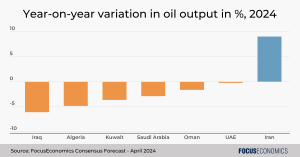In mid-April, Iran launched a barrage of rockets and drones at Israel—an unprecedented direct attack that marks a major escalation of tensions between the two perennial geopolitical enemies. Yet even as the external threats to Iran’s economy have increased, the country’s energy sector has appeared to go from strength to strength, with news reports highlighting that Iranian oil exports have recently risen to a six-year high. So against this two-sided backdrop, what do our panelists think is in store for Iran’s economy?
Iranian oil exports to rise
Our Consensus is for Iran’s oil production to average 3.1 million barrels per day this year, which would be the highest reading since 2018—the year then-U.S. President Donald Trump withdrew from the nuclear deal and reimposed sanctions on Tehran. This will be in stark contrast to the Middle East’s other major oil exporters, which unlike Iran are mostly subject to OPEC curbs: Output from Iraq, Kuwait, Saudi Arabia and the UAE is seen falling this year. As a result, Iran’s economy should grow more quickly than the Middle East and North Africa average in 2024.
Further sanctions to be ineffective
Though Western nations are reportedly readying further sanctions on Iran’s oil sector, they are likely to miss the mark, given Iran’s considerable experience and skill at averting sanctions, and the fact that almost all the country’s oil is already being sold to China, not the West. Plus, U.S. President Joe Biden is unlikely to push hard to enforce sanctions given that lower oil supply could spur already-persistent inflationary pressures and thus dampen his chances of beating Trump in the November elections.
Iran’s economy to be subdued domestically
Deteriorating geopolitics may not overly harm the oil sector, but the same is not true of domestic demand. The national currency has depreciated by over a quarter so far this year in the parallel market as a result of political tensions, which will leave Iran with the unenviable record of having the region’s second-highest inflation rate this year after Lebanon, according to our panelists. This will entrench already tough domestic economic conditions and hit consumer spending and investment in turn.
Conflict with Israel is the elephant in the room
Of course, our panelists’ forecasts assume that there will be no all-out war between Iran and Israel. If this were to occur—which is not off the table, given the hawkish military leadership in both countries and the high risk of political miscalculation—all bets would be off, and Iran’s economy would quickly wave goodbye to its current resilience.

Insight from our panelists
On the oil sector, Goldman Sachs analysts said:
“We estimate that Iran crude oil production has risen by about 0.6mb/d (or over 20%) over the past two years. If the market were to price a higher probability of reduced Iran supply, then this could contribute to a higher geopolitical risk premium. […] While the geopolitical risk premium—the compensation investors demand for the risk that geopolitical shocks reduce oil supply—is difficult to estimate, our rough estimate informed by our pricing framework and the cost of hedging would be around $5-10/bbl.”
On economic conditions at home, EIU analysts said:
“Severe economic hardship and the confrontational foreign policy from which it chiefly stems will continue to create deep public discontent throughout 2024‑28, sparking repeated bouts of social unrest. The regime’s sense of embattlement from hostile forces both domestically and internationally will drive increasingly harsh repression.”
Our latest analysis
China’s economy beat market expectations in Q1.
UK inflation hit a multi-year low in March.
Download our free special report on the natural gas prices outlook

